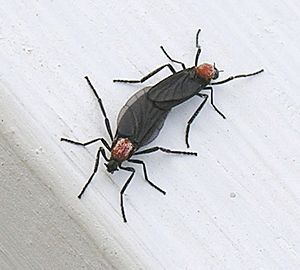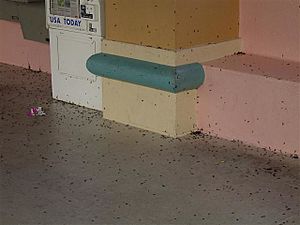Lovebug facts for kids
Quick facts for kids Lovebug |
|
|---|---|
 |
|
| Two lovebugs mating | |
| Scientific classification |
The lovebug (Plecia nearctica) is a type of march fly. You can find them in parts of Central America and the southeastern United States, especially along the Gulf Coast. People also call them the honeymoon fly or double-headed bug. This is because after they join together to make new lovebugs, the adult pairs stay connected, even when flying, for several days.
Lovebugs were first officially described in 1940. However, they were seen in Louisiana as early as 1911. At that time, they were common in Texas, Florida, Alabama, Mississippi, and Louisiana. By the end of the 1900s, lovebugs had spread widely to all areas near the Gulf of Mexico, as well as Georgia and South Carolina. They have even been seen flying high in the air, several kilometers over the Gulf.
Young lovebugs, called larvae, eat decaying plants and other dead plant material. This actually helps humans because it cleans up the environment. Adult lovebugs mostly drink nectar from flowers. They especially like plants like sweet clover, goldenrod, and Brazilian pepper.
Contents
Lovebugs: A Seasonal Sight
Lovebugs can appear in huge numbers, sometimes millions at once! You'll often see male and female pairs joined together, floating slowly in the air. There are two main times each year when lovebugs are most active. The first big flight happens in late April and May. The second one occurs in late August and September. These busy periods last for about four to five weeks. In south Florida, a smaller third flight can happen in December.
Lovebugs are not dangerous to people. They cannot bite or sting, and they don't spread diseases. Their reputation as a nuisance comes from how many of them there are, especially near highways. When cars drive fast, many lovebugs hit the windshields, hoods, and radiator grills. If their remains are left on a car for more than an hour or two, they become very hard to remove.
In the past, the dead lovebugs could even damage car paint and chrome because their body fluids could become slightly acidic. However, modern car paints are much better at resisting this. Today, the biggest problem is that too many lovebugs can clog a car's radiator, which can make the engine overheat. They can also smear on windshields, making it hard to see.
Adult lovebugs are attracted to light-colored surfaces, especially if they are freshly painted. They also gather in many other places, possibly reacting to sunlight on car fumes, asphalt, and other things in the environment. Scientists are still trying to fully understand why they gather where they do.
Lovebug Myths and Facts
There's a popular story that lovebugs were created by scientists at the University of Florida in a genetics experiment that went wrong. The myth says they were trying to control mosquito populations by changing lovebug DNA.
However, research has shown that this is just a myth. Lovebugs naturally spread into Florida and other southeastern states through migration, not because of a science experiment.
Many stories about lovebugs still exist. This is partly because the young lovebugs (larvae) are rarely seen. They live and feed in the grass for most of the year. While some fungi are thought to help control lovebug numbers naturally, studying these natural controls isn't a top priority since lovebugs aren't considered a major pest.
Managing Lovebug Populations
Lovebugs have natural ways of being controlled. For example, certain fungi and dry weather can cause more young lovebugs to die. When lovebugs first spread along the Gulf Coast, their numbers were so huge that people worried and started rumors about where they came from.
However, as insect populations naturally spread, their natural controls usually follow. Over many decades, lovebug flights are no longer as massive as they once were. This is because their natural controls, mostly fungi, have caught up with the established lovebug groups. Sometimes, you might still see very large numbers of lovebugs in certain areas, but these are often due to local conditions that might not happen again the next year.
Most animals that eat insects don't like lovebugs because they have an acidic taste. However, some birds, like quail and robins, do eat lovebug larvae and some adults. Other predators that eat lovebugs include spiders, some predatory insects like earwigs, certain beetle larvae, and centipedes.
Lovebug Life Cycle and Reproduction
Female lovebugs can lay a lot of eggs, usually between 100 and 350. They typically lay these eggs around decaying plant material on the top layer of the soil. Lovebug eggs usually hatch after 2 to 4 days, depending on the time of year.
Once the eggs hatch, the young lovebugs (larvae) start eating the decaying material around them, like dead plants and other organic matter. They live in the soil until they grow into the pupa stage. During warmer months, lovebug larvae stay in this stage for about 120 days. In cooler months, it can be around 240 days. Lovebugs usually stay in the pupa stage for about 7 to 9 days before becoming adults, ready to make more lovebugs.
Once they are adults, lovebugs are ready to join together to reproduce. Adult male lovebugs usually emerge from the pupa stage first. They hover around until the female lovebugs appear. The male and female lovebugs join together almost immediately after the adult females emerge. A male lovebug will stay joined with a female until she has been fully fertilized. This joining can last for 2 to 3 days before the female separates, lays her eggs, and then dies. Adult females have been known to live up to seven days, while adult males may live up to two to five days. On average, lovebugs live for about three to four days as adults.


